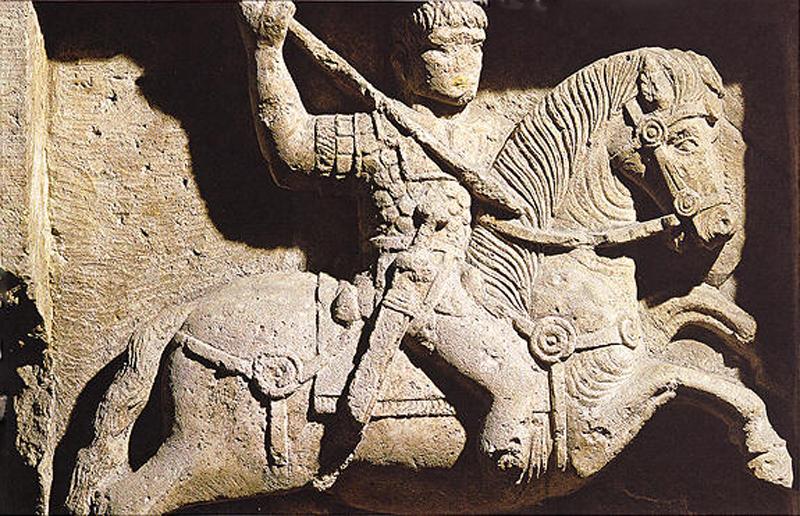A Superb, Original, & Rare, 1st Century BC to AD Republic and Early Imperial Roman Period ‘Hasta’. A Spearhead From the Time of Julius Caesar, Mark Anthony and Octavian, Who Was Later Known As Augustus Caesar
Exactly as used at the Battles of Philippi and Actium. The Powerful Hasta
The hasta was the Imperial Roman legionaries spear of choice. Hasta translates to spear in Latin, this weapon was longer than a sword so they were able to attack their enemy from a farther distance. This form of spear was not intended to be thrown it was mainly used for thrusting. It was 6 and a half feet long, with a shaft made of ash. The head was created from iron, and had a sharp point. Roman soldiers that carried these spears were called, Hastati. Hastae were the main weapon in the time of ancient Rome and probably the most effective. To deprive a soldier of his hasta was equivalent to degrading him to the rank of the velites, who were armed with javelins. A blunt hasta with a button at the end (hasta pilra) continued to be used in later times as a military decoration. The hasta indeed was employed in many symbolical connections. The fetialis, for instance, hurled a blood-stained hasta into the enemy's territory as a token of declaration of war, and if a general devoted his life for his army he stood on a hasta while repeating the necessary formula. The hasta was also set up as a symbol of legal ownership when the censor farmed out the taxes, when state property, booty for instance, was sold; at private auctions (hence called subhastationes), and at the sittings of the court of the centumviri, which had to decide on questions of property.
1st century BC-1st century AD. An iron spearhead with tapering split socket, thick midrib to the leaf-shaped blade, lateral rivet holes and step above the mouth. In Rome, Caesar was appointed dictator,with Mark Antony as his Master of the Horse (second in command); Caesar presided over his own election to a second consulship and then, after 11 days, resigned this dictatorship. Caesar then pursued Pompey to Egypt, arriving soon after the murder of the general. There, Caesar was presented with Pompey's severed head and seal-ring, receiving these with tears. He then had Pompey's assassins put to death.
Caesar then became involved with an Egyptian civil war between the child pharaoh and his sister, wife, and co-regent queen, Cleopatra. Perhaps as a result of the pharaoh's role in Pompey's murder, Caesar sided with Cleopatra. He withstood the Siege of Alexandria and later he defeated the pharaoh's forces at the Battle of the Nile in 47 BC and installed Cleopatra as ruler. Caesar and Cleopatra celebrated their victory with a triumphal procession on the Nile in the spring of 47 BC. The royal barge was accompanied by 400 additional ships, and Caesar was introduced to the luxurious lifestyle of the Egyptian pharaohs Julius Caesar was assassinated in 44 BC, and Octavius was named in Caesar's will as his adopted son and heir. Afterwards, Octavius took the name Gaius Julius Caesar and was called Octavianus. He, Mark Antony, and Marcus Lepidus formed the Second Triumvirate to defeat the assassins of Caesar. Following their victory at the Battle of Philippi (42 BC), the Triumvirate divided the Roman Republic among themselves and ruled as de facto dictators. The Triumvirate was eventually torn apart by the competing ambitions of its members; Lepidus was exiled in 36 BC, and Antony was defeated by Octavian at the Battle of Actium in 31 BC.Octavian pursued them and defeated their forces in Alexandria on 1 August 30 BC—after which Antony and Cleopatra committed suicide. Antony fell on his own sword and was taken by his soldiers back to Alexandria where he died in Cleopatra's arms. Cleopatra died soon after, reputedly by the venomous bite of an asp or by poison. Octavian had exploited his position as Caesar's heir to further his own political career, and he was well aware of the dangers in allowing another person to do the same. He therefore followed the advice of Arius Didymus that "two Caesars are one too many", ordering Caesarion, Julius Caesar's son by Cleopatra, killed, while sparing Cleopatra's children by Antony, with the exception of Antony's older son. Octavian had previously shown little mercy to surrendered enemies and acted in ways that had proven unpopular with the Roman people, yet he was given credit for pardoning many of his opponents after the Battle of Actium 104 grams, 20.2cm (8"). From a private Buckinghamshire, UK, collection; acquired in the 1990s.
Code: 23411
995.00 GBP







